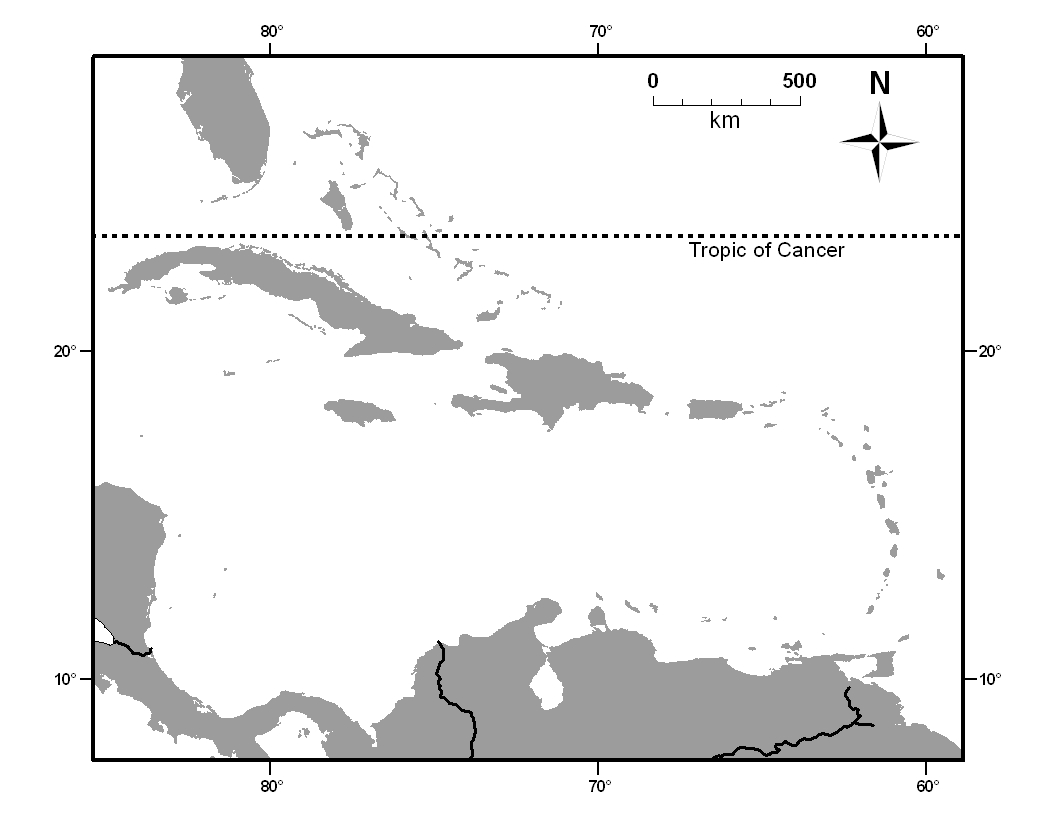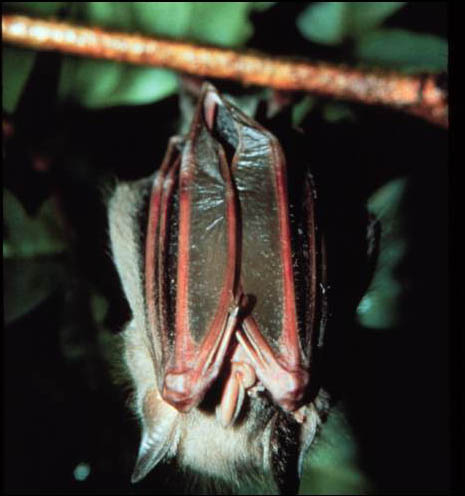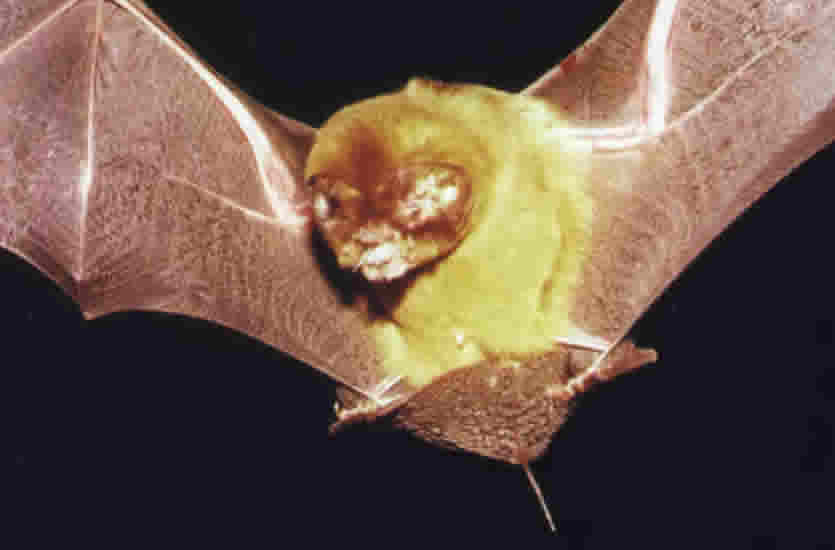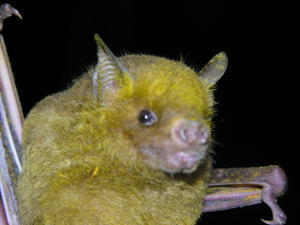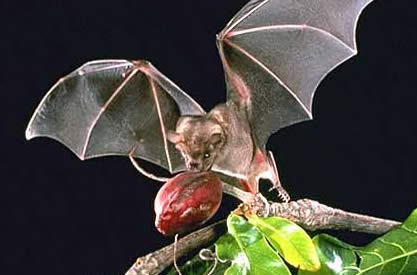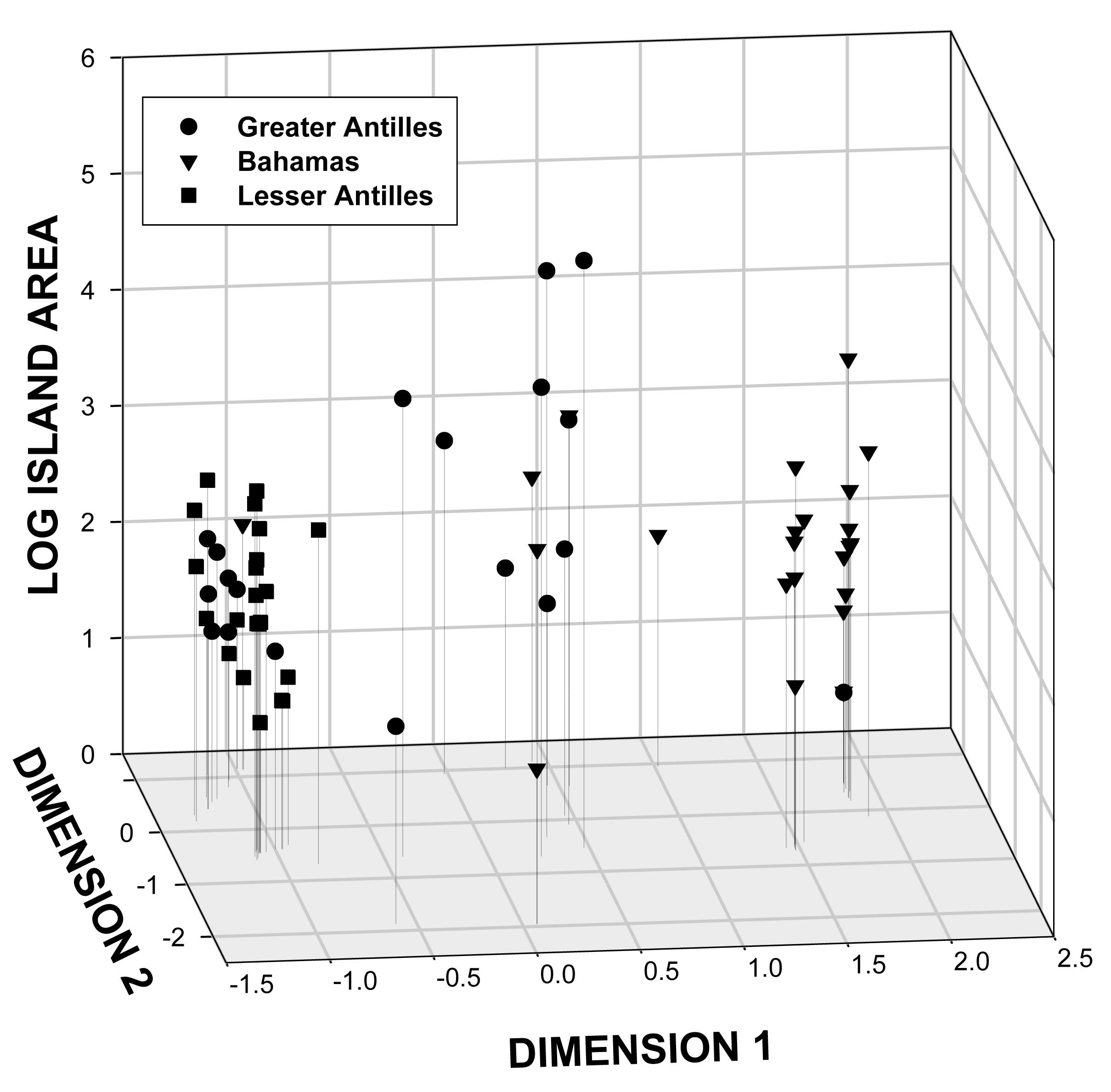
Biogeography of Caribbean Bats |
||||||
Caribbean Islands The Caribbean is an area of high species richness and high species endemism and is recognized as a hotspot of biodiversity. The extent of land represented by constituent islands is relatively small (about the size of the state of Colorado), with Cuba representing roughly two-thirds of that land mass, the Caribbean harbors 7,000 endemic vascular plants and 779 endemic vertebrates. Historical (e.g., geological and evolutionary) and ecological (e.g., island size and distance to mainland) factors contribute to complex patterns of endemism and richness. In addition, changes in climate during the late Quaternary modified the distribution, size, and abiotic characteristics of caves, significantly altering the distribution of bats in the Caribbean. Widespread extinctions of cave-dwelling species on small islands (e.g., Bahamas and Cayman Islands) resulted from flooding that was associated with rising sea levels or erosional collapse.
The Caribbean Basin is a region characterized by high cyclonic activity; therefore, the composition and structure of biotas in the Caribbean have been molded by a disturbance regime dominated by hurricanes for a considerable time. Moreover, global warming likely will increase the number and intensity of tropical storms and hurricanes in the region. Although considerable research has focused on the effects of hurricanes on the structure and function of biotas in the Caribbean, little work has examined how variation in hurricane-related disturbance characteristics might affect patterns of biodiversity on Caribbean islands in general. The Caribbean also is an area of conservation concern because of the extent to which accelerating rates of anthropogenic activity threaten the persistence of species. Symptomatic of this concern, the primary vegetation of the Caribbean extends to slightly more than one tenth (29,840 km2 of 263,500 km2) of its original cover. Conservation action in the Caribbean is more complex than on the mainland of North or South America. The Caribbean is home to more than a score (20) of small nations and territories. The human inhabitants of the Caribbean islands represent a diversity of social, political, and cultural heritages, with populations speaking a variety of languages, challenging the production or execution of comprehensive conservation planning.
Caribbean islands range from 27.33° N to 10.05° N latitude and from 84.96° W to 59.42° W longitude. They differ greatly in physical characteristics and range from small (< 1 km2), low (< 5 m above sea level) cays, with little more than sand and sparse scrub vegetation, to large (114,524.0 sq km2), high (3175.0 m) islands that are physiographically diverse, with many different habitat types. Each Caribbean island belongs to one of three major island groups (Bahamas, Greater Antilles or Lesser Antilles). The Bahamas are low-lying islands (maximum elevation is 63 m) formed from carbonate banks of the Bahamas Platform, a part of the North American tectonic plate. In contrast, andesitic volcanism in the Antilles created more physiographically and geologically diverse islands. Caribbean islands adjoin parts of North, Central and South America, resulting in multiple sources of colonization from the mainland. The three primary continental sources of colonization for Caribbean bats are subtropical North America, the Yucatán of Central America and northern South America. Because there are many (> 7000 islands, islets, reefs, and cays) Caribbean islands, and because they differ greatly in size, elevational relief, sources of colonization, isolation, geological history, and exposure to hurricane-induced disturbance, they represent a valuable opportunity to study effects of environmental variation on species diversity, composition, and community structure.
|
||||||
Caribbean Bats
Reliable data for bats are available for 65 islands throughout the Caribbean, including 58 species, 34 genera, and 7 families of bats from Caribbean islands. More islands and more records of bats are included in this data set than in any previous biogeographic considerations of Caribbean bats. Recent improvements to the knowledge of distributions of Caribbean bats largely are the result of research conducted by Scott Pedersen, Hugh Genoways, and dozens of their colleagues and students. A summary of those efforts and electronic versions of the resulting publications is available on Scott Pedersen's web page. Thirteen species, 13 genera, and 5 families are documented from the Bahamas, 38 species, 25 genera, and 6 families are documented from the Greater Antilles, and 24 species, 17 genera, and 7 families of bats are documented from the Lesser Antilles. Families of bats that occur on Caribbean islands include the Emballonuridae (1 species), Phyllostomidae (24), Noctilionidae (1), Mormoopidae (5), Natalidae (7), Molossidae (7), and Vespertilionidae (13). In addition, Caribbean bats occupy many trophic guilds, including aerial insectivores, frugivores, gleaning animalivores, piscivores, high-flying insectivores, and nectarivores. A comprehensive list of references for bat records on Caribbean islands is available in the appendices of Willig et al. 2009.
|
||||||
Species Richness of Islands
Approach.--We quantified the effect of island area, elevation, latitude, hurricane-related disturbance, and inter-island distances on bat species richness and guild richness and did so separately for each of three groups of islands: Bahamas, Greater Antilles, and Lesser Antilles. Analyses were based on data from 65 islands, including 23 Bahamian islands, 19 Greater Antillean islands, and 23 Lesser Antillean islands. Results.--Regardless of island group, multiple regression analyses based on matrix permutations were consistent for species richness. Only differences in area accounted for differences between islands in species richness. Similarly, only differences in area accounted for differences in guild richness between islands of the Bahamas; however, differences in area and elevation accounted for variation in guild richness between islands of the Greater Antilles or between islands of the Lesser Antilles. Importantly, inter-island distance, hurricane-related disturbance, and latitude were not strong candidates for entry into multiple regression solutions for species richness or for guild richness. Conclusions.--Our results strongly support the contention that area and its correlates (e.g., habitat diversity or elevation) are the primary factors determining variation in the number of species or the number of guilds on islands within the Bahamas, Greater Antilles, and Lesser Antilles. Moreover, spatial attributes such as latitude or inter-island distance explained little to no variation in species richness or guild richness within island groups. Nonetheless, island group was a significant factor affecting species composition. Island group reflected spatial position and proximity to mainland sources of colonization. As such, the relevance of geographic location and proximity to sources of colonization may not be discounted, even though they clearly play a smaller role than does area and its correlates in determining patterns of species richness or guild richness. Finally, local extinctions associated with hurricane-related disturbance may be countermanded by inter-island rescue effects, such that neither characteristic assumes pervasive importance in determining patterns of biodiversity on Caribbean Islands. For more details, see Willig et al. 2009 (not yet in print).
|
||||||
Species Composition of Islands Approach.--Traditional island biogeographic approaches focus on analyses of species richness in which the identity of species is unimportant. To evaluate if island characteristics are important to species compositions (in which species identity is important), we assessed the extent to which island area, maximum island elevation, inter-island distance, and hurricane-induced disturbance affected patterns of species composition and nestedness for bats in the Bahamas, Greater Antilles, and Lesser Antilles. Analyses were conducted for all species, as well as for two broadly defined guilds: carnivores and herbivores.
Results.--For the Bahamas, only inter-island distance accounted for variation in species composition between islands. For the Greater and Lesser Antilles, differences in island area and inter-island distance accounted for differences in species composition between islands. Differences in elevation or hurricane-related disturbance were not related significantly to variation in species composition for any island group. In general, results of analyses restricted to a particular broad guild (i.e. carnivores or herbivores) mirrored those for all bats. Bat species composition was nested significantly in each island group. Nestedness was stronger in the Greater Antilles and in the Lesser Antilles than in the Bahamas. Carnivore assemblages were nested significantly in the Greater and in the Lesser Antilles, but not in the Bahamas. In contrast, herbivore assemblages were nested significantly in each island group. Conclusions.--McArthur and Wilson’s theory of island biogeography predicted species richness based on the effects of island characteristics on rates of immigration and extinction. A secondary prediction related to the equilibrium of immigration and extinction rates was that turnover would occur on islands with the identity of species going extinct or immigrating to islands determined by chance (i.e. at random). However, species composition on Caribbean island was not random. Rather, islands that were more similar in area and islands that were geographically proximate exhibited more similar species composition than did islands that differed in area or were geographically remote. In addition, the structure of bat assemblages was significantly nested on each island group, indicating that ecological or evolutionary factors beyond those considered in the equilibrial model likely structure these assemblages. For more details, see Presley and Willig 2008.
|
||||||
|
Approach.--We evaluated characteristics of species ranges (i.e. coherence, species turnover and range boundary clumping) to determine the structure of bat metacommunities and metaensembles from Caribbean islands. We evaluated the effects of endemic species on that structure, and quantified associations between island characteristics and latent environmental gradients that structure Caribbean bat metacommunities and metaensembles. Results.--Metacommunity structure for all bats and for carnivores was similar for each island group, with Clementsian distributions (i.e. discrete communities with groups of species replacing other groups of species along the gradient) for all islands, the Bahamas and the Lesser Antilles, but with nested distributions for the Greater Antilles. Herbivore distributions were random for the Bahamas, but were Clementsian for all other island groups. Removal of endemic species affected the best-fit model of metacommunity structure in only three of 12 cases. In general, ordination scores for islands were correlated with longitude or latitude, but not with island area or elevation.
Conclusions.--Bats are highly vagile and easily move between islands in the Caribbean, making it likely that isolation (geographic distance from any potential source of colonization) per se does not greatly affect community composition on islands. In the Caribbean, bat species richness is a function of geophysical islands characteristics (Willig et al., 2009); however, these characteristics do not determine which species occur on an island or the structure of metacommunities. Rather, locale of origination and associated specialization of particular species, the number of colonization sources and the proximity of islands to each source of colonization combine to shape bat metacommunity structure in the Caribbean. A single continental colonization source, many species of Bahamian origin and high bat vagility combined to create a Clementsian structure with a single aggregation of species in the Bahamas. In contrast, the Lesser Antilles have two sources of colonization, resulting in Clementsian structure with multiple aggregations of species whose boundaries likely are determined by environmental tolerance, resource availability, or priority effects. In the Greater Antilles, a significant radiation of bats occurred on the larger islands, which are closest to mainland sources of colonization. As a result, the recently evolved taxa on larger islands are the primary sources of colonization for smaller, more isolated islands, and successful dispersal of bats combine with hierarchical distribution of habitats to promote the formation of nested species distributions. Characteristics of bat species ranges and associated metacommunity structure primarily were dependent on the number and geographic arrangement of primary sources of colonization, and not on interspecific interactions, species-specific levels of environmental tolerance, or the physical characteristics of islands. Endemic species did not greatly affect metacommunity structure in Caribbean bats. For more details, see Presley and Willig 2009.
|
||||||
Future work We hope to produce multiple series of papers for additional Caribbean vertebrate taxa (e.g., birds, amphibians,reptiles), with each series composed of at least 3 papers investigating patterns of species richness, species composition, and metacommunity structure. We are preparing the first of the paper concerning birds in collaboration with Joseph Wunderle of the International Institute of tropical forestry. In addition, we have tentative plans to collaborate with Blair Hedges of The Pennsylvania State University on papers concerning the amphibians and reptiles.
|
||||||
|
Collaborators on Island Biogeography Research
|
||||||
Related Publications Presley, S. J., and M. R. Willig. 2008. Composition and structure of Caribbean bat (Chiroptera) assemblages: effects of inter-island distance, area, elevation, and hurricane-induced disturbance. Global Ecology and Biogeography 17:747-757. Willig, M.R., S.J. Presley, C.P. Bloch, and H.H. Genoways. 2009. Macroecology of Caribbean bats: effects of area, elevation, latitude, and hurricane-induced disturbance. Pages 216-264 in Island bats: evolution, ecology, and conservation (T. Fleming, and P. Racey, Eds.). University of Chicago Press. Presley, S.J., and M.R. Willig. 2010. Bat metacommunity structure on Caribbean islands and the role of endemics. Global Ecology and Biogeography 19:185-199. |
Please contact steven.presley@uconn.edu or michael.willig@uconn.edu if you have questions, comments, or corrections. Unless otherwise indicated, figures, tables, and images that appear on this page may not be used, reproduced, copied, or posted elsewhere, for any reasons, without permission. |
